An Unfair Comparison
While it is possible to compare the music Handel and Bach wrote for voices, a similar comparison is out of the question with regard to their music for instruments alone.
Handel never devoted his attention to music of this kind in a whole-hearted way. It is true he wrote works of almost every kind, but they were the offshoots of his genius written for some special occasion, to fill up a blank space in his concert programs, or for the benefit of his fashionable pupils.
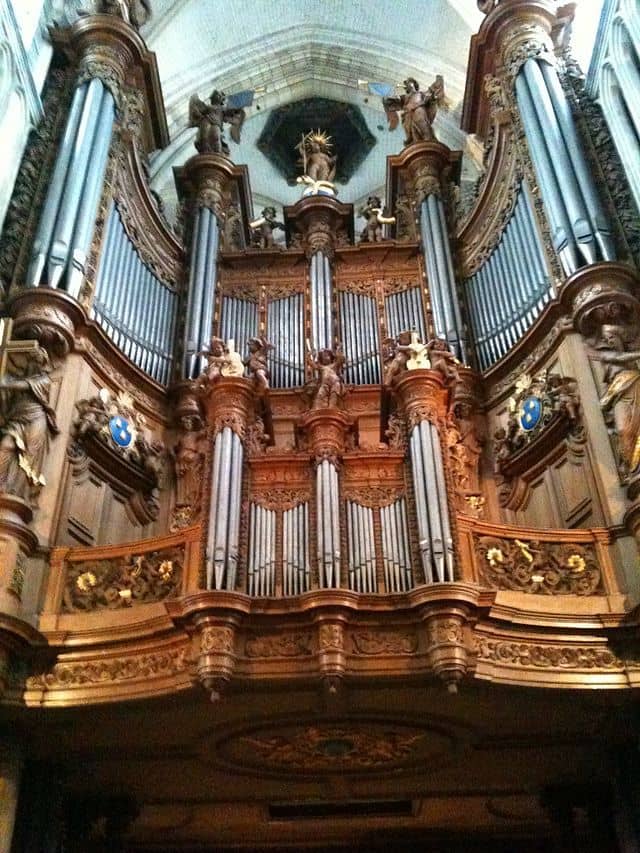
Bach, on the other hand, began life as an instrumental composer. Much of his earlier time was devoted to composition for his own instrument—the organ. Then, when he was at the height of his powers during the time that he spent at Kothen (1717-23), he gave himself up to the composition of music for instruments alone.
As a result, he produced a mass of splendid works of every conceivable kind. He thus formed a style of his own quite unlike that of his predecessors or contemporaries. Consequently, his work for instruments marches far ahead of Handel’s. To try to compare the two would be rather unfair to Handel.
Nevertheless there are beautiful things in Handel’s works of almost every kind. If we consider that most of them were rapidly written—seemingly thrown off in the spare moments of his busy life—we can realize something of the strength of his genius from them.
Handel’s instrumental music can be divided for our purpose into three classes, and we shall look only at a few examples in each class. There is
- Music for the harpsichord alone which was equivalent to piano music, since it is now often played on the piano.
- Chamber music, that is to say, sonatas for two or three instruments intended to be played in private houses rather than in public.
- Music for an orchestra, which includes a number of concertos for the organ accompanied by the orchestra (Handel used to play these between the parts of his oratorios), as well as some concertos for orchestral instruments, plus overtures and other pieces which were included in his operas and oratorios.
Harpsichord Music
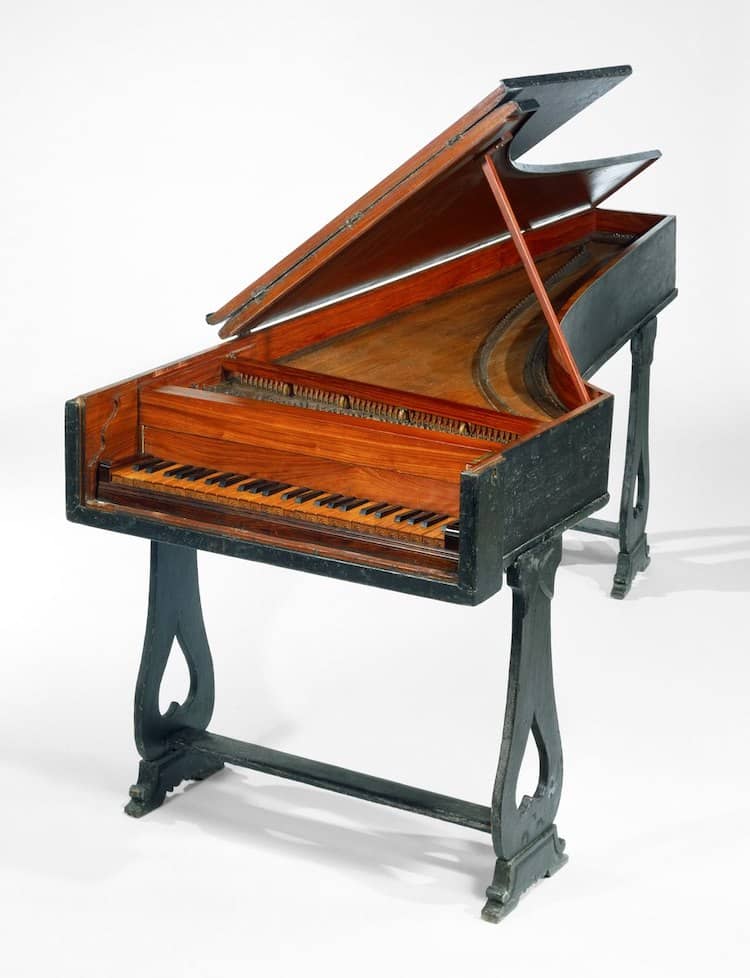
Handel’s harpsichord music was written for his pupils. It consists of suites, lessons, fugues, and other pieces.
We have already mentioned the suites and lessons of Purcell and the ‘ordres’ of Couperin. Handel’s were planned in much the same way, except that he did not confine himself to dance tunes to the same extent. Instead of having a great number of little pieces in one suite, he generally preferred to have only four or five; he also liked to make them longer than the older writers were able to do.
The actual order of pieces in a suite was always a matter for the composer’s own taste, but still there were certain arrangements which were the most usual.
For instance, the suite generally began with a movement called either Prelude (which means something that is played first) or an ‘Allemande’ which is a German piece in a quick and fluent style. A ‘Courante’, an old French running dance, would generally follow, and after it a ‘Sarabande’ would frequently come, since it was a slow dance which contrasted well with the quick ones which had gone before. Next would come one or more ‘Menuets’, a ‘Gavotte’, and possibly others, with a quick dance, preferably the ‘Gigue’, to make a cheerful ending.
Handel’s suites contain movements of all these kinds, but they do not appear at all in the accepted order. Several of them have both a prelude and an allemande as the first movements. The second begins with an adagio, the fourth with a fine fugue which, properly speaking, had no place in the suite form.
Some of them contain airs with variations, such as the fifth suite, which ends with the tune called ‘The Harmonious Blacksmith’. How it got its ridiculous name is quite unknown. Certainly Handel never called it that, and if he had wanted to write a piece to illustrate the sound of a blacksmith’s hammer on the anvil he would have done it much more realistically than this simple little tune does; probably the name was made up by some publisher who thought it would make the piece sell, and if so, events have proved that he was right, for ‘The Harmonious Blacksmith’ has become by far the most famous harpsichord piece that Handel ever wrote.
Listen to the Air and Variations from ‘Harpsichord Suite No. 5’ HWV 430 (4 min)
The main point to realize, however, is that Handel’s suites are not planned on any fixed form. He wrote a set of movements which would group well together. Generally, the best movements were not the allemandes, courantes, and sarabandes which were the common property of suite writers, but those which he imported from other kinds of work, such as the fugues (Suites IV and VIII) and the presto which ends Suite III (in which two themes are contrasted in a highly original way).
The gigues, however, are an exception, for Handel had a special fondness for their delightful rhythm which, like Scarlatti, he had probably caught from Corelli when he was a young man in Italy. Sometimes when he started a really good gigue theme it seems as though his delight in it would never stop, and as though he were determined to show that the dancers would be exhausted long before his powers of invention would be. The gigue ending Suite IX in G minor is a splendid example.
Now that we have Handel’s suites before us, it is a good time to discuss a little more specifically what a fugue is.
Understanding Fugues
To do so we must go back to the distinction which we discovered in the first lessons between polyphonic (having more than one ‘voice’ at the same time) and homophonic (having one ‘voice’ at the same time).
Now the dances of the suites all belong more or less to the second class, that is, they are harmonized homophonic tunes. But a fugue is like a round; there must be several voices or parts each of which sings or plays a tune at the same time which agrees in harmony with all the others.
Let us suppose for the sake of clarity that the fugue is sung by four people with different types of voices: treble (highest), alto (middle high), tenor (middle low), and bass (lowest). The idea is that each should begin by singing the same fragment of melody, a fragment which is to be the chief point of the whole of the fugue, just as the Biblical text is the chief point of a sermon.
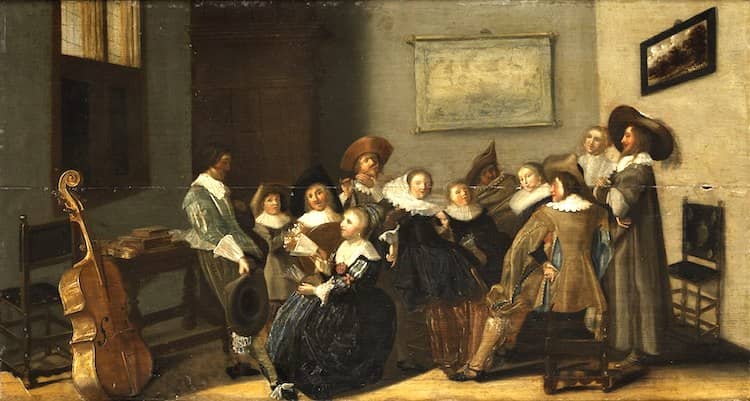
Suppose that the treble sings it first. The alto will have to sing it on lower notes because his voice is lower. While the alto sings the subject the treble goes on singing a new tune called the counter-subject, which harmonizes with the subject, but is quite distinct from it.
Next the tenor enters singing the subject an octave below the treble while the alto goes on to the counter-subject, and finally the bass voice begins an octave lower than the alto. So far the fugue is very much like a round, for all the voices sing the same music in turn, only they do not sing it upon the same notes.
But they do not follow each other singing the same music through the whole work as the singers of a round do, for after each has sung the subject and the countersubject there is no strict rule as to what shall happen next.
The voices return from time to time to the subject and counter-subject, singing them now in one part, now in another, sometimes changing to another key, or from the major to the minor, sometimes altering them, and sometimes singing them in longer or shorter notes.
Then, as the fugue draws near the end, one voice may begin the subject and another enter also singing it before the first has finished, so that they seem to catch each other up. (This device is called a ‘stretto’ ) The whole must be well-planned so as to give all the prominence possible to the subject itself, so it is exceedingly important that the subject should be a really fine bit of music which it is worth while to make prominent.
Listen to a fugue by Bach BWV 1080 played by a string quartet (4 min)
Listen to 4:18. This is taken from Bach’s “Art of the Fugue”. Note how at the start the first violin states the subject alone. Then the second violin picks it up as the first violin continues with the counter-subject. Next, the cello picks up the subject, and the second violin picks up the counter-subject. Finally, the viola comes in last to pick up the subject. From that point forward, listen to how they pick up, change, and adjust the music using the subject and counter-subject.
The treatment of a subject in fugue is perfectly natural when it is sung by different voices or played upon different instruments, each one of which carries on its own part. As we have seen, all the earlier polyphonic music was written for a number of different voices; it was written that way so each might bear an equal part in the interest of the performance.
But when the fugue is played on a single instrument—such as a harpsichord, piano or organ—it requires a certain amount of imagination on the part of the listener. You have to imagine that there are several voices or instruments carrying on the separate parts, and to follow their course with your ears in order to understand what is going on.
You can see how the fugue was transferred from real human voices to the pretended ones of a harpsichord if you compare one of the Six Grand Fugues by Handel with the chorus ‘They loathed to drink of the river’ from his oratorio Israel in Egypt.
Listen to ‘They loathed to drink of the river’ from Israel in Egypt (2 min)
Next, listen to the same music written for harpsichord. You will be able to pick out the different ‘voices’ as they come and go through this piece.
Listen to ‘Six Grand Fugues, No. 5’ HWV 609 played on Harpsichord (2 min)
Listen to approximately 2:00 to hear how the fugue is established and then varied.
Both pieces have the same subject, and, in spite of differences in detail, are practically the same piece of music.
In the oratorio, the bold subject seems to picture the disgust of the people at the polluted river; in the harpsichord fugue, it is just as striking an effect even though it is not connected with any particular story.
Your ear is caught every time that great striding subject comes in, and you listen for its contrast with the theme in descending semitones that grows up out of the counter-subject as the fugue advances.
Notice at time 0:43 where the bass starts the subject and the treble comes in with the same tune two octaves higher before the bass has finished. This gives a perfect example of the way a subject stamps its character upon the whole course of a fugue. We shall consider this aspect of the fugue more fully when we come to those of Bach.
Chamber Music
The most important things in Handel’s chamber music are nineteen sonatas for violin and harpsichord. For the most part, they follow the plan of Corelli’s works of the same kind. They have four movements: slow-quick-slow-quick, with the last one normally in the rhythm of a gigue.
Handel followed a curious custom which his predecessors also used. Instead of writing everything the harpsichord was to play, he simply wrote the bass line and put figures under it to show what chords the right hand was to supply.
This seems rather vague, since it leaves all the details of the harpsichord music to be filled in according to the taste of the player. In modern editions, it has been filled in by a later musician in a style as much like that of the composer as possible.
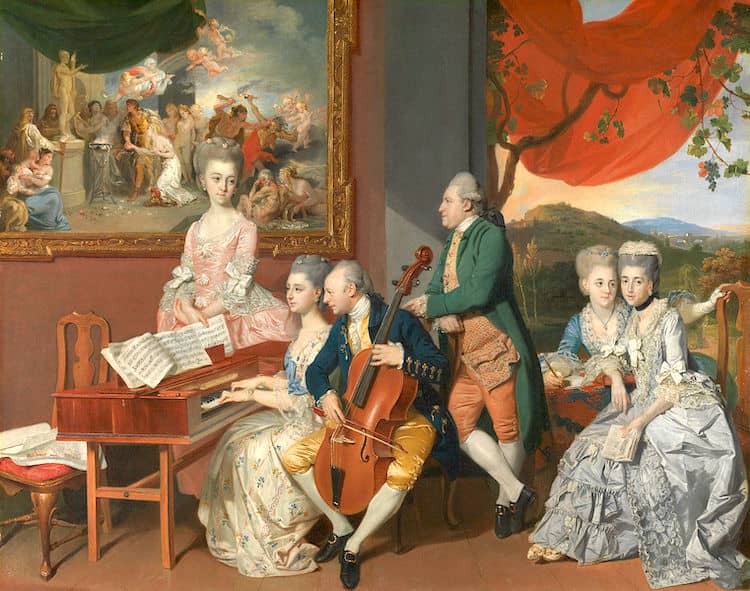
In this sense, the sonatas were thoroughly homophonic and not polyphonic. That is to say, the tune of the violin was the chief thing; the bass was only important because it made the harmony clear. The middle parts were so unimportant to Handel that he thought it unnecessary to write them down.
Although Handel’s style is generally larger and broader than Corelli’s, one sometimes finds themes in these sonatas which remind one very much of Corelli.
Listen to Handel’s Violin Sonata in D Major, II. Allegro HWV 371 (3 min)
Start at 4:15 for the second movement. Performed by “Novum Consort” on original instruments. As always, you’re welcome to listen all of it.
Timings: 1 Affettuoso 0:00 | 2 Allegro 4:17 | 3 Larghetto 6:59 | 4 Allegro 9:47
Orchestral Music
We saw how the elder Scarlatti and others gradually sorted out the mixed collection of instruments which Monteverdi and others had assembled into a group. We also saw how they decided on the stringed instruments—violins, violas, violoncellos, and double basses—as the best foundation for an orchestra.
It became recognized that every orchestra must contain a certain number of these instruments. But a great deal of diversity continued to exist as to the use of wind instruments.
Handel relied upon oboes and bassoons as a permanent part of his orchestra. In many of his overtures to operas, he got striking effects by contrasting their thick reedy tone with the sharper, clearer tone of the violins.
Handel’s oboe concertos are perfect examples of how he contrasted the unique sounds of a wind instrument with the violins. The oboes are not sufficiently prominent in them to take the place as solo instruments which the organ holds in the organ concertos, but they add a good deal of variety to the tone.
Listen to Handel’s ‘Oboe Concerto in G Minor, II. Allegro’ HWV 287 (2 min)
Note how the unique sound of the oboe contrasts with the violins.
Most of the other wind instruments which belong to the modern orchestra were perfectly well known in Handel’s day. What was not so well known was how to combine them with the strings.
Handel frequently used trumpets and drums when he wanted big effects; for instance, he does this in some choruses of the Messiah such as ‘For unto us’ and ‘Hallelujah’. All the instruments of Beethoven’s orchestra were familiar to Handel with one important exception—namely, the clarinet. Nevertheless, his normal orchestra was much smaller; we may say that it consisted of strings, oboes and bassoons, trumpets and drums (used sparingly), and that flutes, horns, trombones, and harp were all extra instruments.
This gives some notion of the means which Handel had at disposal. The next thing is to see how he used them. His works for the orchestra alone consist chiefly of concertos with a few additions such as the suites called ‘Water Music’ and ‘Music for the Royal Fireworks.’
Water Music
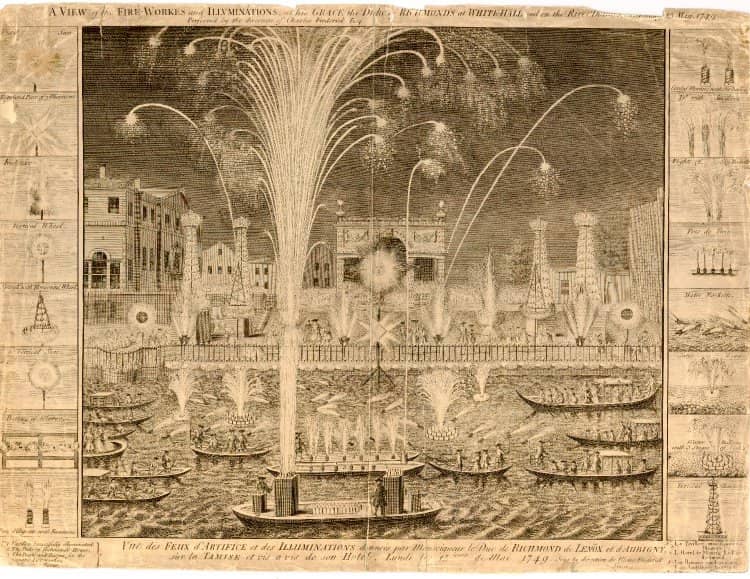
The legend concerning the origin of the Water Music refuses to die. The story goes that Handel had enraged his employer, the Elector George of Hanover, by his prolonged absence in England. When in 1714 Elector mounted the throne of England as George I, Handel was in an embarrassing position; but two of his friends planned a tactful reconciliation between the composer and the king.
A royal water party was to take place on the Thames in honor of the new king. Handel’s friends arranged to have the royal barge followed by a band of musicians performing music Handel had written expressly for the occasion. And—so the story goes—the consequence was that Handel’s suite, composed in his most ingratiating vein, so seduced the king that, on learning the composer’s identity, he forgave Handel and bestowed on him a life pension of two hundred pounds.
Unfortunately, this story seems to have been entirely made up.
A report by the Brandenburg envoy to the English court at the time proves that the Water Music was composed not in 1714 but in 1717, and under altogether different circumstances. He wrote:
’’Some weeks ago, the King expressed a wish to Baron von Kilmanseck to have a concert on the river by subscription, like the masquerades this winter which the King attended assiduously on each occasion…. By the side of the Royal Barge was that of the musicians to the number of fifty who played all kinds of instruments, namely trumpets, hunting horns, oboes, bassoons, German flutes, French flutes, violins and basses, but without voices. This concert was composed expressly for the occasion by the famous Handel. … It was so strongly approved by H.M. that he commanded it to be repeated, once before and once after supper, although it took an hour for each performance.”
Though the long-accepted tradition about the Water Music is thus, once and for all, proved apocryphal, there is nothing legendary about the music’s permanent capacity to enchant audiences. It is light, tuneful, and varied, consisting of six movements: Allegro, Air, Bourree, Hornpipe, Andante, and Allegro deciso.
Listen to the ‘Hornpipe’ movement from Water Music (4 min)
Music for the Royal Fireworks
In 1748-49, the peace signed at Aix-la-Chapelle ended hostilities between the English and the French. In London, the treaty was celebrated with great ceremony. Handel was commissioned by the court to write music for the peace celebration which was scheduled to take place in Green Park, London.
Handel’s music was so eagerly and impatiently awaited that, when he rehearsed it at Vauxhall Gardens, twelve thousand people attended—traffic being held up on London Bridge for over three hours. The music was to be preceded by one hundred and one brass cannons thundering a Royal salute announcing the beginning of the fireworks. Then Handel’s music was to be played, with eighteen smaller cannons firing single shots during the performance.
Handel’s music was a triumph—as it turned out, the only triumph of the entire celebration. A fire started accidentally by the fireworks set the great building ablaze and sent the people into a stampede, thus converting a great event into an outright fiasco.
King George II realized Handel’s music was the only saving feature of a rather shabby affair. Therefore when Handel later performed the work for the benefit of the Foundling Hospital, the King subscribed two thousand pounds out of his esteem for the music.
The Fireworks is of inexhaustible charm. It comprises an overture, a Largo alia Siciliana (written to commemorate the peace), an Allegro (descriptive of the joy of the occasion), a Bourree, and two Minuets. The work is scored for wind instruments and drums.
Listen to the opening of the Music for the Royal Fireworks (2 min)
Listen until 1:45 when the drum solo begins. This performance was recorded during the 2012 BBC Proms in London, an 8-week event filled with classical music concerts. Although many nationalities have performed Handel’s music, it is the British who most love his music. This is a passionate performance for an enthusiastic audience. Of course, you’re always welcome to listen longer.
Organ Concertos
Handel composed three volumes of organ concertos. Two of these volumes were published in his own time.
The Handel organ concerto was an outgrowth of his organ improvisations. He performed these between acts of his oratorios to entertain audiences. Frequently, he introduced within his concertos musical material from his oratorios. In the third concerto (of the third volume) we find a minuet from Esther. His concerto nicknamed “the Cuckoo and the Nightingale” has a similarity to Solomon.
These concertos for organ range from three to five movements. The tempos (speed of playing) of the movements are normally fast-slow-fast. As one contemporary wrote, they are full of “broad masses of light and shade. Strong and sharp contrasts are the striking traits of this music, whose chief aim is to make a monumental effect on a huge gathering of people.”
Listen to the Andante first movement of Organ Concerto Op.7, No. 1 (5 min)
Listen until 4:40, unless you want to listen to all of it. It is an excellent performance by the multi-talented German organist/conductor Karl Richter leading his Münchener Bach Orchester (Bach Orchestra of Munich). The movements are not separated by pauses in playing, but progress from Andante, Fugue/allegro, Andante, Largo, and Bourree (allegro).
Concerti Grossi
Handel also wrote 18 Concerto Grossi (‘Grand Concertos’) for stringed instruments that were very popular (and still are). They were published under two sets: Opus 3 including 6 concerti and Opus 6 including 12 concerti.
These last are the only ones in which there is a single solo instrument featured. Since Handel was accustomed to play the organ part himself, he never took the trouble to write these solo parts out fully, but used to trust largely to his memory—or to his inventive power at the moment—to make them effective. Since his day, these have all been filled in.
The other concertos all bear much the same relation to Corelli’s works of the kind. That is to say, their general plan is like his, but they are freer and finer both in their musical ideas and in their treatment of those ideas.
Handel adopted the same plan of having a group of solo players and a stringed band as an accompaniment; the group of soloists in the oboe concertos were the oboe players and a violinist; in the ‘grand concertos ’ they were two violinists and a violoncellist.
Listen to ‘Concerto Grosso Op 6, No. 1, I. Allegro’ HWV 319 (3 min)
Final Thoughts on Handel’s Approach
In speaking of the orchestra, people sometimes talk of ‘color.’ What they mean is that the tone of each instrument can be compared to the colors on a painter’s palette.
The art of combining them is very similar to that of the painter. When the tones of the instruments are well blended, they produce an almost infinite number of subtle lights and shades which you would never have suspected could emerge from the few simple tones of the separate instruments.
To use this common comparison, in most of his work Handel only reached the power of laying on colors in a few broad washes, as some of the early Italian painters of frescoes in ‘tempera’ did. In a few instances, however, he did reach the intimate combinations of sound which correspond to the more delicate effects of color similar to that used in more detailed oil paintings.
This is a point which no amount of explanation or even the study of scores can make clear. You can perceive it more quickly by listening to an overture by Handel and then a symphony by Beethoven. The development of instrumental music from the Baroque era to the Classical era is one in which the use of musical color significantly changes.
As we move along in the story of music, it will be easier for you to tell these differences by looking back at Handel once you’ve learned the music of the ‘classical’ composers: Haydn, Mozart, and Beethoven. Yet before we do that, we will explore the music of the only Baroque composer who truly understood the possibilities of color in a way that was absolutely unique in the history of music: Johann Sebastian Bach.

